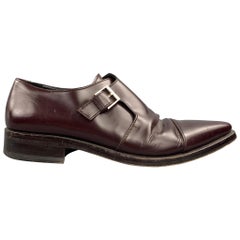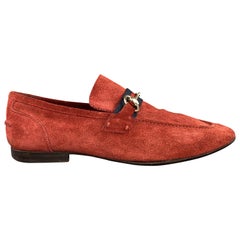Gucci Loafers 9
Recent Sales
21st Century and Contemporary Italian Shoes
21st Century and Contemporary Italian Shoes
21st Century and Contemporary Italian Shoes
21st Century and Contemporary Italian Shoes
21st Century and Contemporary Italian Shoes
21st Century and Contemporary Italian Shoes
21st Century and Contemporary Italian Shoes
21st Century and Contemporary Italian Shoes
21st Century and Contemporary Italian Shoes
21st Century and Contemporary Shoes
21st Century and Contemporary Italian Shoes
21st Century and Contemporary Italian Slippers
21st Century and Contemporary Shoes
2010s Italian Shoes
2010s Italian Shoes
2010s Italian Moccasins
21st Century and Contemporary Italian Shoes
2010s Shoes
21st Century and Contemporary Italian Shoes
Gucci Loafers 9 For Sale on 1stDibs
How Much is a Gucci Loafers 9?
Gucci for sale on 1stDibs
Long before trend-bucking creative director Alessandro Michele brought his hallucinatory “Utopian Fantasy” campaign to Gucci, it was a modest Italian leather shop. Today, it’s an internationally renowned luxury house with an iconic logo, and vintage Gucci clothing, handbags and shoes are among high fashion's most covetable goods.
Guccio Gucci (1881–1953) admired the stylish suitcases he saw wealthy guests arrive with at the Savoy Hotel in London, where he worked as a bellhop. So, in 1921, after a stint at Franzi, a luggage company in his hometown of Florence, he opened a leather goods shop of his own.
At first, Gucci’s Florence business specialized in equestrian accessories. But as its reputation flourished, particularly among the English aristocracy, so too did its footprint. In 1938, he brought three of his sons — Aldo, Vasco and Rodolfo — into the business and expanded it to Rome and later Milan. In the mid-1930s, a League of Nations embargo against Italy pushed Gucci to experiment with alternatives to imported leather. Its woven hemp fabric from Naples, adorned with the brand’s signature diamond print, was a hit, especially among A-list celebrities. The material was first used on suitcases before finding enduring popularity on handbags. (No list of revered designer purses would be complete without Gucci.)
In the 1950s, Elizabeth Taylor carried one of Gucci’s bamboo-handled tote bags, another adaptation to material rationing. After Jackie Kennedy was seen sporting a slouchy Gucci tote in 1961, it was renamed for the First Lady. Then Grace Kelly, on a visit to the boutique in Milan, inspired Rodolfo Gucci to work with Italian illustrator and Gucci textile designer Vittorio Accornero on the Flora print in 1966. Taking cues from Sandro Botticelli’s Primavera, with its pattern of flora and insects, it was painted entirely by hand and featured no fewer than 37 colors.
In 1953, just 15 days after opening his first store on New York’s 5th Avenue, Guccio passed away at 72. The early 1970s saw store openings in Tokyo and Hong Kong, but by the late 1980s, Gucci was floundering. Rodolfo Gucci took charge in 1982, but family drama and lawsuits ensued. In 1993, Rodolfo’s son, Maurizio, transferred his shares in the company to Investcorp, ending the family’s involvement in Gucci. Dawn Mello, then-president of Bergdorf Goodman, joined as creative director in 1989. But it was Tom Ford, who took over as creative director in 1994, who ultimately revived the brand.
Ford’s racy ads, shot by photographers such as Mario Testino, stirred controversy. And his potent vision of sexed-up femininity — with “jewel-toned satin shirts unbuttoned to there,” as Vogue described his breakthrough 1995 runway show — was wildly successful. The new millennium brought new ownership — Pinault Printemps Redoute in 2004 — and a more toned-down vision from Frida Giannini, who became sole creative director in 2006. Alessandro Michele was named creative director in 2015, and the storied brand took a giant leap forward.
Find vintage Gucci clothing and accessories on 1stDibs.
- Are Gucci shoes worth it?2 Answers1stDibs ExpertFebruary 22, 2021Gucci shoes are well-made using high-quality materials. As long as you're careful with them, Gucci shoes should last at least a few years through regular wear.Couture ClosetsMarch 23, 2021Simply, Yes. From fit, craftmanship, to quality of materials, to comfort level...A Gucci shoe lasts, period. If cared for, a Gucci shoe is sustainable, a "staple", timeless, always in style and donated or resold when you have moved on.
- Are Gucci watches good?1 Answer1stDibs ExpertFebruary 22, 2021Gucci watches are more fashion than function, so if you want a super-stylish watch that simply tells time, a Gucci watch is great. However, if you're looking for a highly functional one, you may want to look at watch brands known for their functionality, such as Rolex.
- 1stDibs ExpertApril 5, 2022Gucci Marmont is a collection of handbags crafted with matelassé leather. Matelassé is the stitching technique that gives Marmont bags their classic padded look. You’ll find a variety of Gucci Marmont bags from some of the world’s top sellers on 1stDibs.
- What is Gucci ophidia?1 Answer1stDibs ExpertApril 5, 2022Gucci Ophidia is a line of handbags from a collection that premiered in 2018. Primarily crafted from canvas, the iconic stripe and webbed design exudes vintage charm. You’ll find a variety of Gucci handbags from some of the world’s top sellers on 1stDibs.
- What do I wear with Gucci mules?1 Answer1stDibs ExpertApril 5, 2022What to wear with Gucci mules really comes down to personal preference! Boasting an open back and a sleek design, you can dress Gucci mules up with tights or pair them with jeans for a laid-back look. On 1stDibs, find a collection of Gucci footwear from some of the world’s top sellers.
- Is Gucci made in Italy?1 Answer1stDibs ExpertMay 3, 2024Whether Gucci is made in Italy depends on the piece. The vast majority of the luxury fashion house's clothing, bags and accessories do come from workshops in Italy. However, Gucci manufactures its watches in Switzerland and some of its eyewear in Japan. Find a variety of Gucci apparel and accessories on 1stDibs.
- 1stDibs ExpertFebruary 22, 2021You can tell if a Gucci belt is real by looking at the sticker on the Gucci belt that contains a serial number and phrase “Made in Italy”. The serial number should be 21 digits long and will typically begin with the numbers 223 or 114. Many knockoff Gucci belts have serial numbers beginning with 1212.
- 1stDibs ExpertFebruary 22, 2021The best way to distinguish whether or not a Gucci purse is real is by looking for the serial number tag. These are typically located on the leather patch on the top of the inside. Find a variety of authentic Gucci handbags and purses on 1stDibs.Couture ClosetsMarch 21, 2021Stitching Should Be Even, Interior Tag Should Be Intact, Monogram Pattern Should Be Clear and Symmetric, Hardware Should Be Top Quality, Body Made From Premium Leather, Check Dustbag and Authenticity Cards, Logo Should Be Clear & Precise.

